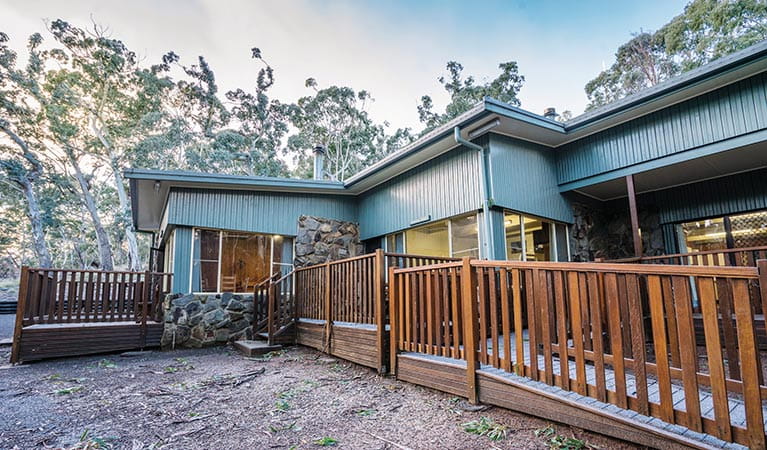Dawsons Spring cabins
Mount Kaputar National Park
Overview
Surrounded by beautiful snow gums with a wood fire and walking and cycling nearby, rest your head at Dawsons Spring cabins in Mount Kaputar National Park.
| Accommodation type | Cabin |
|---|---|
| Maximum guests | 4 |
| Facilities | Drinking water, showers, toilets, electric power, balcony, indoor fireplace, kitchen, plates and cutlery, pots and pans, rubbish bin |
| What to bring | Bed sheets, blankets, pillows, towels, drinking water, food supplies |
| Please note |
|
The semi-detached Dawsons Spring cabins, nestled amongst enormous snow gums, are a great place to escape to for the weekend.
Spend your days exploring the wonders of Mount Kaputar National Park on one of the many nearby walking tracks, like the Dawsons Spring Nature trail or walk to the summit of Mount Kaputar for panoramic views. Bring your mountain bike to explore some of the park’s trails, go birdwatching or search for wildlife by torchlight at night.
If you’re just looking to relax, Dawsons Spring cabins offer simple accommodation where you can curl up with a book, sit by the wood fire or gaze at the mist rising around the snow gums in winter. It's a wonderful weekend getaway.
Map
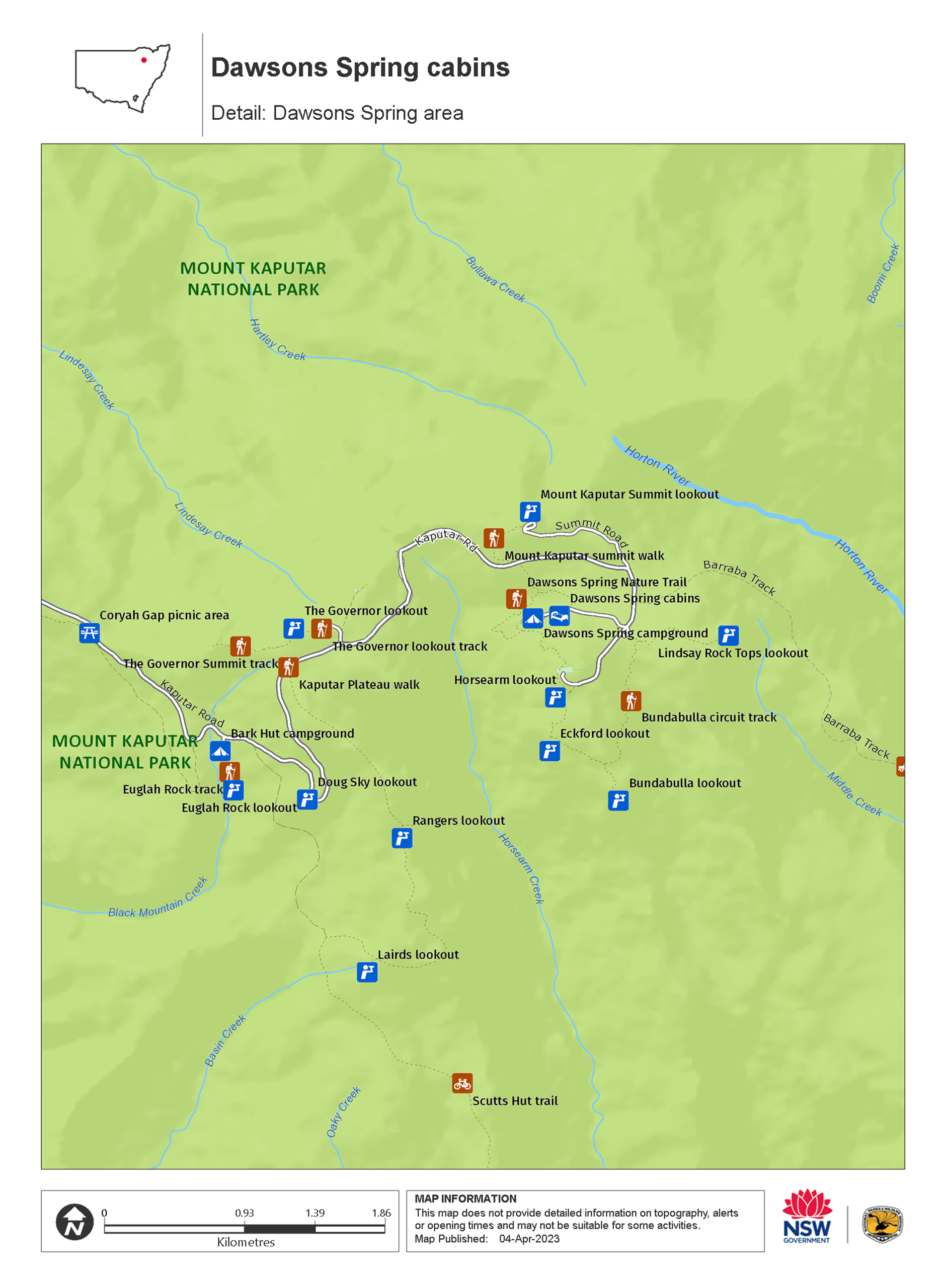
Map legend

Local alerts
For the latest updates on fires, closures and other alerts in this area, see https://www.nationalparks.nsw.gov.au/camping-and-accommodation/accommodation/dawsons-spring-cabins/local-alerts
Bookings
- National Parks Contact Centre
- 7am to 7pm daily
- 1300 072 757 (13000 PARKS) for the cost of a local call within Australia excluding mobiles
- parks.info@environment.nsw.gov.au
Operated by
- Narrabri office
- Monday to Friday, 8.30am to 4.30pm.
- 02 6792 7300
- npws.barwon@environment.nsw.gov.au
- Level 1, 100 Maitland Street, Narrabri NSW 2390. Accessible via Dewhurst Street.
Park info
- in Mount Kaputar National Park in the Country NSW region
Mount Kaputar National Park is always open but may have to close at times due to poor weather or fire danger.
Visitor info
All the practical information you need to know about Dawsons Spring cabins.
Getting there and parking
To access the cabins, you'll need the PIN code sent in your booking confirmation email. Call 13000 72757 if you haven't received your code.
Dawsons Spring cabins are in the Kaputar Plateau section of Mount Kaputar National Park. To get there:
- Travel east from Narrabri on Old Gunnedah Road
- After about 2.5km turn left onto Kaputar Road and continue for 30km to the park
- Once the road enters the park it becomes steep and winding for another 20km. Caravans and motorhomes are not permitted on this section of the road.
- After you reach the t-junction, turn right and take the next right into Dawsons Spring. The cabins will be located on your left.
- The drive will take you about 1 hour from Narrabri
Road quality
- Unsealed roads
Vehicle access
- 2WD vehicles
Weather restrictions
- All weather
Parking
Designated parking for up to 2 vehicles per cabin is available next to the cabins. Additional vehicles can be parked in the nearby day use area.
Best times to visit
There are lots of great things waiting for you in Mount Kaputar National Park. Here are some of the highlights.
Autumn
This is one of the best times of year to visit the park, with ideal temperatures for bush walking, cycling and camping.
Spring
A beautiful time of year to enjoy the abundant wildflowers and birds.
Summer
Escape the heat of the plains by heading up into the park.
Winter
Experience the mist surrounding the high plateau area and enjoy the beauty of the occasional blanketing of snow. Be prepared for the temperatures about 10°C cooler than in the nearby town of Narrabri.
Weather, temperature and rainfall
Summer temperature
Average
21°C and 35°C
Highest recorded
43.4°C
Winter temperature
Average
7°C and 18°C
Lowest recorded
-5.6°C
Rainfall
Wettest month
January
Driest month
August
The area’s highest recorded rainfall in one day
188mm
Facilities
- There are 3 self-contained cabins and all are open plan with no separate bedrooms.
- The 3 cabins are next to each other with adjoining walls and staggered front entrances. The cabins are in the order of Logan, Manning and Dickson.
- Dickson cabin: 1 double bed.
- Logan and Manning cabins: 1 double bed and 1 single bunk bed.
- All mattresses have plastic protective covers.
- Bathroom with hot shower and flush toilet.
- Table with 4 chairs.
- Please leave the property clean and tidy with all kitchen items washed up and put away. Additional fees may be charged for any unreasonable cleaning required or missing/broken items.
Toilets
- Flush toilets
Drinking water
Some water is available at the property but you’ll need to treat or boil it before drinking. Water is sourced from the Dawsons Spring.
Showers
- Hot showers
Electric power
The cabins use mains power.
Balcony
Each cabin has a verandah.
Indoor fireplace
Firewood is supplied.
Kitchen
Each cabin has a kitchenette with fridge/freezer, microwave, stove cook-top, toaster, kettle.
Plates and cutlery
Pots and pans
Rubbish bin
Located behind the cabins.
Maps and downloads
Accessibility
Disability access level - medium
Dickson cabin is wheelchair accessible with assistance as the PIN-coded rear entrance door has stairs. Ramp access is via the
front verandah. The bathroom and kitchen facilities are wheelchair friendly.
Logan cabin and Manning cabin are not wheelchair accessible.
Permitted
Fires are permitted in the fireplaces only. Some firewood is provided for your cabin. There is a locked firewood box next to the cabins.
Prohibited
Caravans, motorhomes, chemical toilets and amplified music are not permitted.
Gathering firewood
Firewood can't be collected from the park.
Generators
Pets
Pets and domestic animals (other than certified assistance animals) are not permitted. Find out which regional parks allow dog walking and see the pets in parks policy for more information.
Smoking
NSW national parks are no smoking areas.
Learn more
Dawsons Spring cabins is in Mount Kaputar National Park. Here are just some of the reasons why this park is special:
A harsh lifestyle
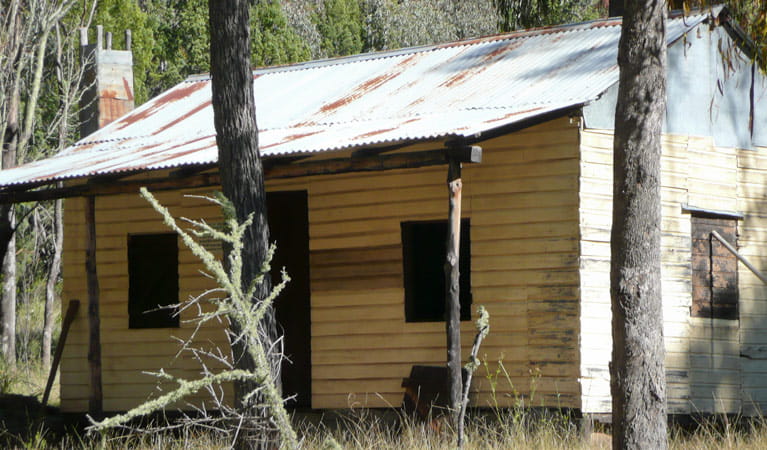
Several pioneering families lived in the Mount Kaputar area in extremely harsh conditions. Stockmen looked after sheep and cattle on the Kaputar Plateau, often going for months without seeing another person. Enjoy a walk to the historic Scutts Hut to experience the pioneers' harsh lifestyle. The Scutt family lived in the hut in the 1940s and 50s, and it has been carefully restored to its original condition. Most of the materials to build the hut and furniture were brought in by horse - even the rainwater tank.
An ancient heritage
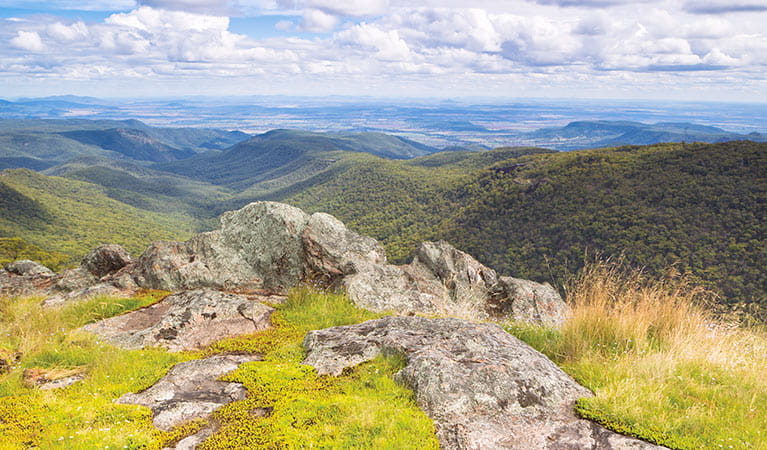
Mount Kaputar National Park is the traditional Country of the Gamilaroi Aboriginal people. The park provided a rich resource for food, medicines, shelter and weapons and the landscape is part of Dreaming stories. Reminders of the Gamilaroi's connection to this ancient landscape are evident in Aboriginal rock carvings, campsites, marks on trees and axe grinding grooves throughout the park.
Colourful locals
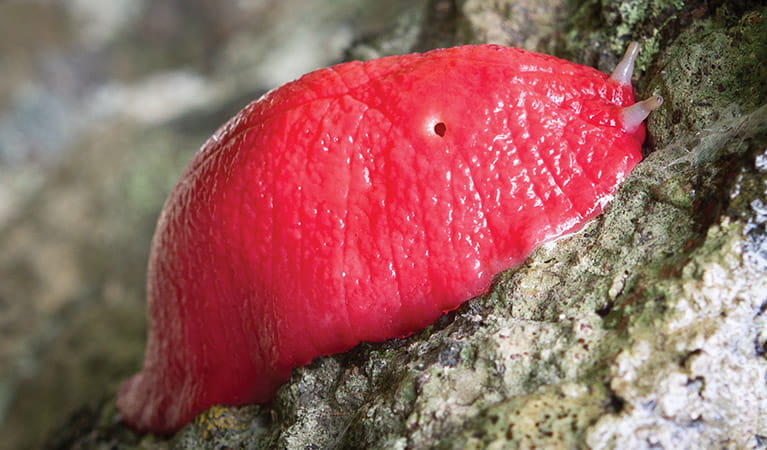
Mount Kaputar is famous for a very unusual, colourful local - a bright pink slug. It can be seen after rain on rocks, trees and amongst the leaf litter. With birds from both the east and west meeting together at Mount Kaputar, the park is also a wonderful place to go bird watching. More than 185 bird species live in the park, so don't forget your binoculars. A torch will also come in handy for seeing some of the other locals that come out at night, including possums and greater gliders. And watch out for the many kangaroos and wallabies, too.
- Dawsons Spring nature trail Dawsons Spring nature trail is an easy walk from Dawsons Spring campground in Mount Kaputar National Park, near Narrabri. Great for families, you'll enjoy seasonal waterfalls, wildflowers and wildlife spotting.
- Euglah Rock walking track Ideal for walking with kids, Euglah Rock walking track in Mount Kaputar National Park leads to a lookout offering stunning scenic views of Euglah Rock and beyond.
Action or relaxation
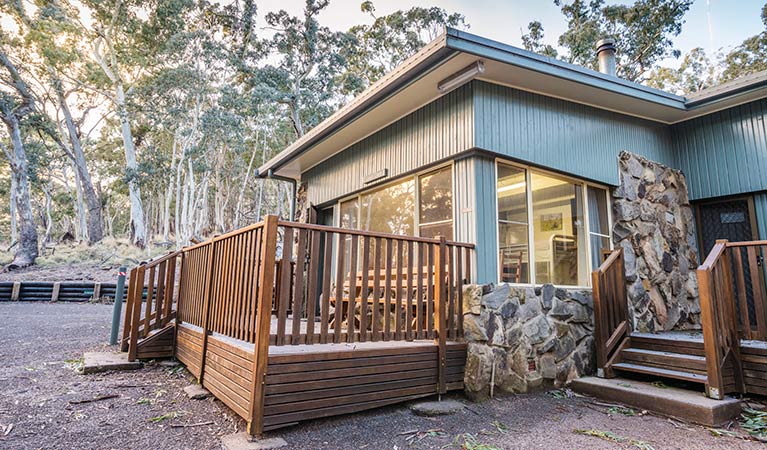
Mount Kaputar National Park is packed with walks, cycling and 4WD trails, plus plenty of scenic spots for camping and picnicking. Test your mountain bike legs up the steep Mount Kaputar Road to the Kaputar Plateau, or the challenging Barraba track. Enjoy a bite to eat at a serene picnic area before walking it off as you take in the stunning scenery. Don't miss the incredible Sawn Rocks formation. There's so much to see, why not book a cabin or set up camp for a few days to make the most of your country getaway.
- Sawn Rocks picnic area Sawn Rocks picnic area is located at the start of Sawn Rocks walking track in Mount Kaputar National Park. It’s ideal for barbecues and picnics with scenic views of North West NSW.
- Waa Gorge picnic area Waa Gorge is one of Mount Kaputar National Park’s most stunning attractions, and this picnic area offers enough sights to enjoy the show over a long lunch.
Over 20 million years in the making
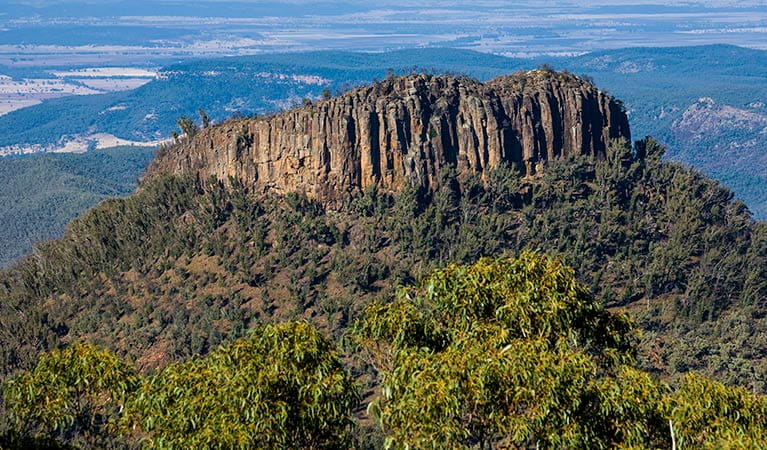
Two volcanos pushed Mount Kaputar high above the plains, and millions of years of erosion have carved a dramatic landscape of narrow valleys and steep ridges. Many of the mountains are ancient lava terraces. Experience ancient history for yourself by standing on Lindsay Rock Tops - an excellent example of a lava terrace. Or visit Sawn Rocks to see one of Australia's best examples of a spectacular rock formation called organ-piping - it really does look like a wall of giant organ pipes.
- Bundabulla circuit walking track Bundabulla circuit walking track connects several walking tracks together. It offers a terrific bushwalking experience with places to picnic along the way and views of Mount Kaputar and surrounds.
- Dawsons Spring nature trail Dawsons Spring nature trail is an easy walk from Dawsons Spring campground in Mount Kaputar National Park, near Narrabri. Great for families, you'll enjoy seasonal waterfalls, wildflowers and wildlife spotting.
- Doug Sky lookout Doug Sky lookout in Mount Kaputar National Park offers scenic views over north-west NSW and Warrumbungles.
- Kaputar scenic drive Kaputar scenic drive is a 20km driving route through dramatic landscapes, with access to lookouts, picnic spots and walking tracks.
- Sawn Rocks walking track This easy walk beside a shady creek bed leads you to a spectacular rock formation - the unique, organ-pipe cliff face of Sawn Rocks and scenic views.
Plants and animals protected in this park
Animals
-
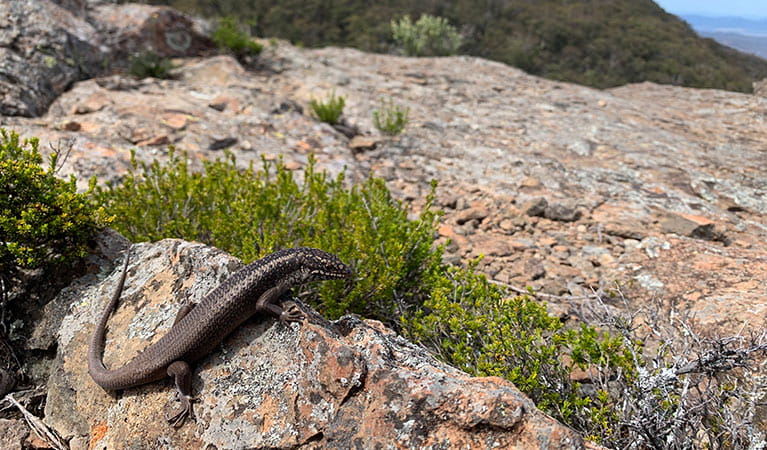
Kaputar rock skink (Egernia roomi)
The critically endangered Kaputar rock skink is found only in the high rocky peaks of Mount Kaputar National Park. With one of the smallest ranges of any vertebrate in NSW, this rare reptile is at risk of extinction.
-

Southern boobook (Ninox novaeseelandiae)
The southern boobook, also known as the mopoke, is the smallest and most common native owl in Australia. With a musical 'boo-book' call that echoes through forests and woodlands, the southern boobook is a great one to look out for while bird watching.
-
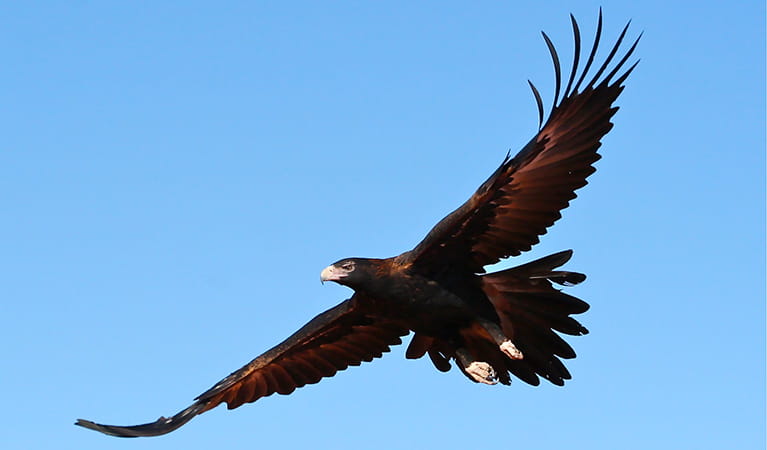
Wedge-tailed eagle (Aquila audax)
With a wingspan of up to 2.5m, the wedge-tailed eagle is Australia’s largest bird of prey. These Australian animals are found in woodlands across NSW, and have the ability to soar to heights of over 2km. If you’re bird watching, look out for the distinctive diamond-shaped tail of the eagle.
-
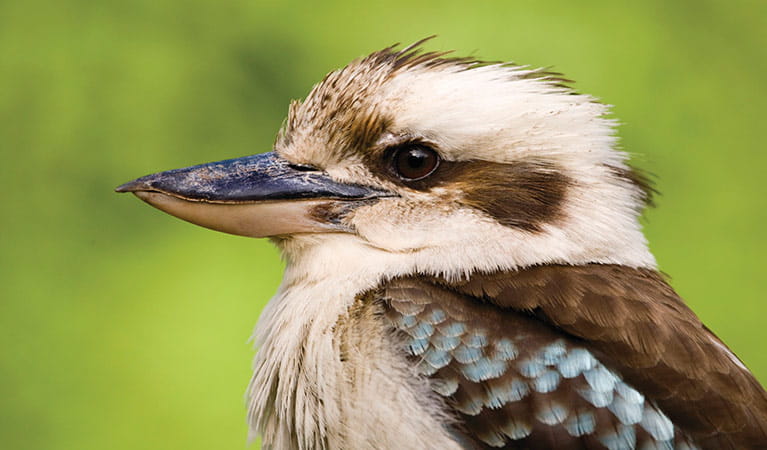
Kookaburra (Dacelo novaeguineae)
Of the 2 species of kookaburra found in Australia, the laughing kookaburra is the best-known and the largest of the native kingfishers. With its distinctive riotous call, the laughing kookaburra is commonly heard in open woodlands and forests throughout NSW national parks, making these ideal spots for bird watching.
Plants
-
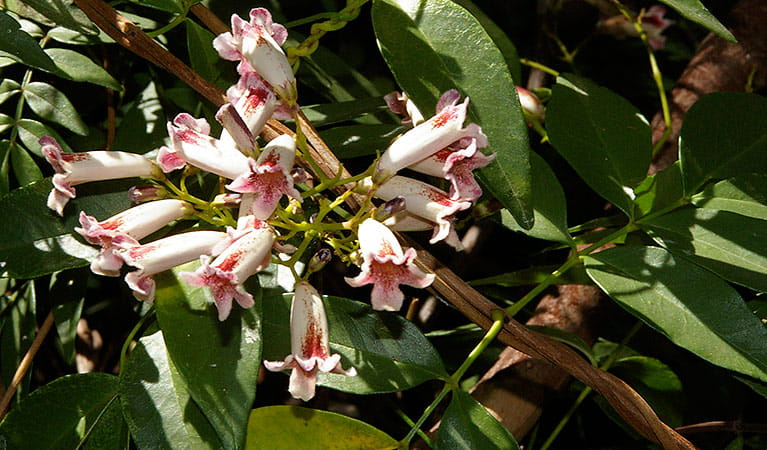
Wonga wonga vine (Pandorea pandorana)
The wonga wonga vine is a widespread vigorous climber usually found along eastern Australia. A variation of the plant occurs in the central desert, where it resembles a sprawling shrub. One of the more common Australian native plants, the wonga wonga vine produces bell-shaped white or yellow flowers in the spring, followed by a large oblong-shaped seed pod.
-

Grass tree (Xanthorrea spp.)
An iconic part of the Australian landscape, the grass tree is widespread across eastern NSW. These Australian native plants have a thick fire-blackened trunk and long spiked leaves. They are found in heath and open forests across eastern NSW. The grass tree grows 1-5m in height and produces striking white-flowered spikes which grow up to 1m long.

